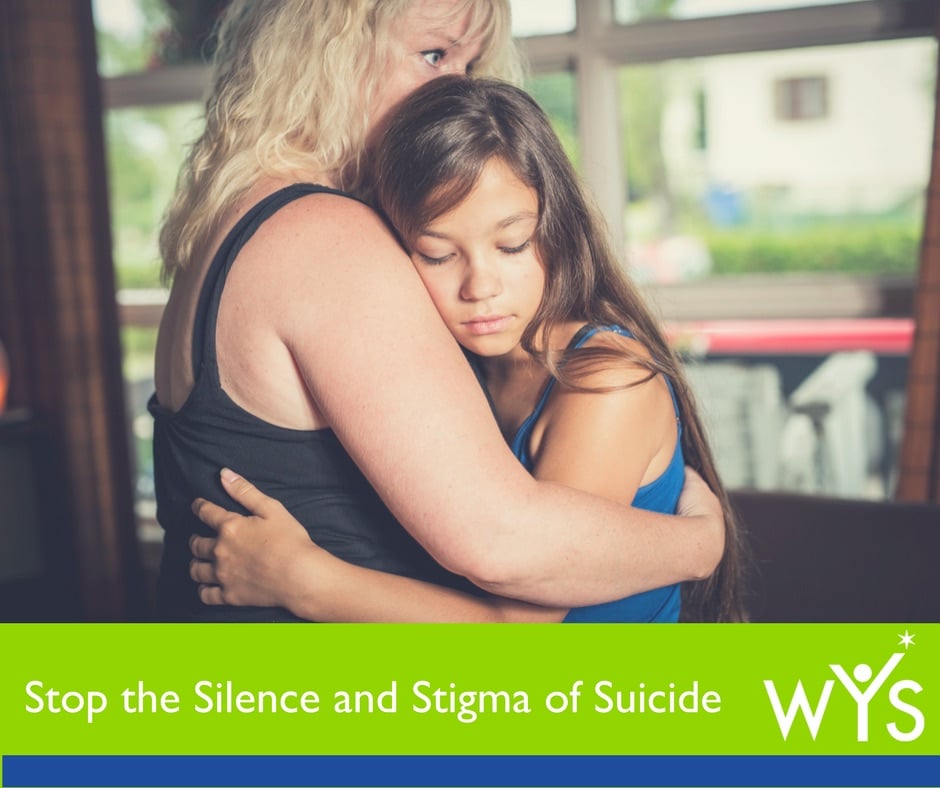
Stop the Silence and Stigma of Suicide
The most powerful tool that we have in preventing suicide is showing care, compassion, and empathy to those contemplating it.
Stop the Stigma of Suicide
Take, for example, the raw and real stories shared on the website Live Through This which contains a collection of portraits and stories of suicide attempt survivors, as told by those survivors. Below is a powerful description from their website.
“’Suicide’ is a dirty word in this country. It’s a sin. It’s taboo. It’s selfish. It’s not an easy topic to discuss and because we, as a culture, don’t know how to approach it, it’s easily swept under a rug. The problem is that suicide is a pervasive public health issue. I get it: we’re afraid of death. But avoiding it and pretending it doesn’t exist is nothing more than willfully perpetuating ignorance.”

There are several recurring themes that run throughout the survivor’s personal journeys:
- Almost all have lived through multiple adverse childhood experiences (ACEs). When not addressed in childhood, these incidents turn into toxic stress that is carried through life. This is heavy baggage for a child and crushes hope, dreams, and possibilities.
- They have patterns of unhealthy relationships that keep them feeling down.
- The patterns are often passed down in their families and/or communities. If the pattern of dysfunction is not broken, it continues to be passed down to future generations.
- When they reach out for help and talk about their pain, life changes… they see how they can live through this and many survivors move on to help others.
Werther Effect vs Papageno Effect
Many people have been speaking recently about the Werther Effect or “suicidal contagion.” This refers to the uptick in suicidal tendencies that arise after a famous person dies by suicide or a TV show (for example, the Netflix series “13 Reasons Why”) illustrates the issue graphically. The fear here is that information like this inspires “copycat suicides” and encourages people to go through with an attempt.
A recent study by Journal of American Medical Association (JAMA) reports that in the days and weeks following the show’s debut, the rate of internet queries on suicide were 19% higher than expected, which equates to about 1.5 million more searches for “suicide,” “how to kill yourself,” or “commit suicide.” However, there was also an uptick in searches for suicide hotlines and resources to get help.
The idea that we shouldn’t talk about suicide at all because of these effects is challenged by the “Papageno Effect,” which shows that when suicide is spoken about with a focus on overcoming ideation and utilizing positive, hopeful and inspiring language, it is highly beneficial, if not healing.
To date, there is significantly more research conducted on the Werther Effect, and it has its merits, but we also know that the Papageno Effect is real. Although this is a difficult subject any way you consider it, the conversations must happen openly in families, communities, and the media which holds major influence in our society. This is not going away. Suicide is real and cannot be swept under the rug. Alternatively, let’s leverage the awareness and raise the level of the conversation to help people in pain and those around them to collectively heal.
How to Discuss Suicide
Trying to help someone that may be at risk can be intimidating. Not only is it a sensitive subject, but there is conflicting information about how to approach a conversation about suicide so that it will be helpful. The objective is: talk about it.
In honor of Suicide Prevention Week below are a few key strategies for communicating effectively with those who may be contemplating ending their own lives or supporting someone whose life has been affected by suicide.
1. Communicate with care, not an accusation.
The JED Foundation created “13 Reasons Why: Talking Points,” a comprehensive list of ways for parents, guardians, and teachers, to approach difficult conversations about suicide related to the Netflix series 13 Reasons Why related to the topic of suicide. A few key points are:
- Talking opening and honestly about emotional distress and suicide is ok. It will not make someone more suicidal or put the idea of suicide in their mind. If you are concerned about someone, ask them about it.
- Don’t judge them or their thoughts. Listen. Be caring and kind. Offer to stay with them. Offer to go with them to get help or to contact a crisis line.
Gain their confidence, do not fuel their feeling of fear, guilt or shame; this will only intensify their negative emotions, and lessen the likelihood of them reaching out to you or someone else again. Offer suggestions on how they can reach out for professional help.
2. How to talk to children and teens about suicide.
Unfortunately, suicide and suicidal ideation is prevalent and affects children and teens of all ages. Regardless of whether you are speaking to a young person who is having suicidal feelings or the talk is about a friend, classmate, or relative, be mindful of the words you use. This is a scary and complex subject and if they do not understand the level of conversation, they will be confused and they may retreat and refrain from talking to you,
If you need guidance on how to approach the topic with someone you care about, use simple, but honest phrases to inform but not overwhelm or reach out for professional help, we provide a few options below.
3. Do not judge those who have taken their own lives… but don’t glorify them, either.
Focus on the fact that although suicidal ideation may be triggered by a recent incident, these internal conflicts are usually the result of deep-rooted, corresponding issues, which can include but are not limited to toxic stress resulting from childhood trauma, depression, anxiety, or other mental health issues.
4. Share stories of healing and resiliency.
Rather than suggesting how “scary” or “selfish” a suicide attempt would be, or comparatively referencing those who have already taken their lives, relate with stories of survival and hope. Focus on how people have moved on from these thoughts, and what techniques and sources have helped.
5. Reach out for professional mental health services.
Suicide is never a solution. It is an irreversible choice regarding a temporary problem. There is help. If you are struggling with thoughts of suicide or know someone who is, talk to a trusted adult, call 1-800-273 TALK (8255), or text “START” to 741741. If you are in the Orange County, CA area, contact a mental health professional at WYS. If you believe that you or a loved one is currently at high-risk, call 911 or immediately transport them to a hospital to receive care.
Suicide is an Epidemic
Generally speaking, suicidal ideation or attempt is the result of someone exceeding their capacity for the pain they feel. This creates a desire to “escape” by any means necessary. It often correlates with other issues that we will address in future articles.

As one of the leading causes of death year-round, suicide is an epidemic. Statistics show that close to 800,000 lives are lost to suicide each year, and it is the second leading cause of death among young people aged 15-29. 78% of suicides around the globe occur in low and middle-income countries, and the single most important risk factor is whether or not someone has discussed wanting to end their life or has made an attempt in the past. Not all people who discuss feeling suicidal follow through, but almost everyone who attempts or completes suicide mentioned those feelings in the past.
There are many factors that will lead someone to believe that suicide is the solution. IT IS NEVER THE SOLUTION. This is why it is crucial to keep an open dialog and to closely watch the actions of the young people in our lives for the warning signs which can be quite subtle. In our article, 13 Reasons Why We Must Speak About Teen Mental Health, we compiled the most prevalent 13 adversities and/or teen mental health conditions that our clients experience.
Therefore, every conversation with people discussing wanting to end their lives should be taken seriously. Our aim is to help people develop coping skills so they never get to the point of suicidal ideation and by helping those who are at that point to recognize that there are so many other ways to find healing and happiness again. Those who are contemplating taking their own lives typically do not really want to die, rather, they want to be able to live without feeling overcome by their pain.
Guiding them to that path is possible, but the time to speak out is now. Join me in having these important conversations.

Lorry Leigh Belhumeur, Ph.D.
Chief Executive Officer
Western Youth Services







